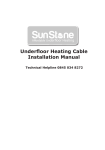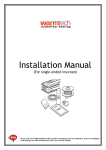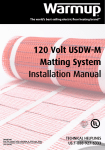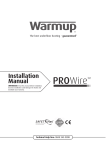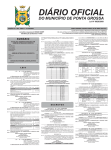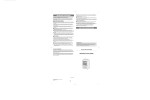Download User Manual
Transcript
Step 3: Insulate & Secure Step 1: Prepare & Measure (a) Substrate Preparation (b) Make a plan Use a highly polymer modified (flexible) cementitious floor adhesive suitable for undertile heating systems when installing the insulation boards and the tiles. • Always round down your floor area e.g. for a floor area of 2.6m² you will require 2m² of heat mat (to avoid surplus wire) • Draw a plan of your room with measurements and all floor fitting objects e.g. cupboards, bath etc. Calculate the free floor space so you know which size mat or combination of mats you will need. • Mark on your plan where your thermostat will go, and therefore where your matting will start from, and continue to draw a plan of how your matting will be laid. • Electrical wiring regulations prohibit thermostats being installed in bathrooms; if you are using the system in a bathroom then install the thermostat on an internal wall outside the bathroom as close to matting power supply cables as possible. Wooden subfloors: Tile Adhesive Heat Mat Sensor/ Protective Tube Insulation Board Adhesive Wooden Floor All floor boards must be secure, level and fixed firmly with screws. If not level then use a self-levelling compound or overlay with WBP plywood. The Heatwave insulation boards are not a strengthening material and should only be used on a sound, flat and rigid substrate. Concrete subfloors: Bathroom Example: Tile Adhesive Heat Mat Sensor/ Protective Tube Insulation Board Adhesive Concrete Floor (b) Install & Fix Boards must be installed with flexible powder based tile adhesive suitable for undertile heating. Use a notched floor trowel to apply a bed of adhesive to your substrate (Trowel in one direction to avoid air pockets). Work a board at a time and firmly press down to ensure no air pockets. When adhesive is completely dry apply Heatwave Glass Fibre tape to edges of board (see picture 2). please note: do not install thermostat on an interior bathroom wall (picture 1) (a) Adjust the mat (c) Stick the mat down Using your markings on the floor and the mesh, with scissors carefully cut the mesh at the necessary points; DO NOT cut the red wire! Ensure the wire is kept 70mm apart for optimum heat distribution. Refer to the adjustment guide on the reverse for help on turning the mat. Working from the thermostat, start to stick the matting down by removing the printed backing tape from the matting and firmly pressing down. Secure the sensor with either tape or tile adhesive, ensure that it does not cross any heating wires. 350mm Check the mark on the floor you made for the location of the sensor (leave enough excess cable to reach the thermostat). The sensor should be under the mat in the middle of two heating wires and 350mm into the heated area, although not directly over heating pipes beneath the floor. A small channel may be needed in the floor to accommodate the tube (in heat mat box), which protects the sensor. Thread the floor sensor through the tube and tape over the end to stop any adhesive entering. Measure the room to calculate number of boards. To cut the boards, simply score through the top layer with a utility knife and snap. The boards should be installed in a staggered pattern (see picture 2). Substrate must be clean, dry and free from dust before installing Step 2: Heat Control Step 4: Lay Matting (b) Prepare for the floor sensor (a) Plan, Measure & Cut • Any floor preparation e.g. levelling, reinforcing or laying of Heatwave Insulation Board (recommended) should be done prior to marking. • Mark the floor where permanent objects and the thermostat are going. Using your plan, roll out the mat (remember your gloves!) from your thermostat point, without removing the printed backing tape and mark the points where the mesh will have to be cut for turning the mat or where the mesh may have to be removed from the red wire to be applied loose into narrow areas. • Draw the planned route on the floor, for any loose wire sections, maintaining the 70mm spacing. Loose wire can be fixed in place using Heatwave Glass Fibre Tape • Plan the location of the heat sensor. • Select either LCD or Manual thermostat • Optimum efficiency • LCD can be programmed for convenience • Refer to thermostat instructions for fitting and technical information The concrete floor should be level and completely cured, if new. The floor should be clean and dust free. The floor should be structurally sound and free from damage. sensor protective tube thermostat (c) Mark the floor and mat Sections d-e ESSENTIAL FOR YOUR WARRANTY (d) Connecting up (By the Electrician) Install the Heatwave thermostat as per the instructions in its box and run the power lead through the electrical protective casing/conduit (not supplied) up the wall, with the floor sensor, to the thermostat. (e) Testing the mat (By the Electrician) Test the mat and sensor with a multi-meter, check the readings with the data tables on the relevant instructions and write this data on the warranty application form. Before tiling, turn on the system and run for approx 10mins to ensure the wire heats evenly. The wire is tough enough to withstand light foot traffic but plastic sheeting or cardboard should be overlaid if the mat will be exposed for any period of time to protect the wire from being damaged by foreign objects or being dislodged from the mesh. (picture 2) Step 5: Tile FAQs Using self-levelling compound: A flexible tile adhesive suitable for under floor heating must be used. This option gives you a smooth flat base to tile onto whilst protecting the wire when tiling. Simply mix the compound and pour over the mat to a depth that covers the wire making sure there are no air bubbles or voids. Allow to fully cure and then tile. Is there a guarantee? There is a 10 year guarantee on the mat and 2 year on the thermostat. To validate your warranty the necessary form must be filled in and sent to us, which can be found in the Heat Mat or Thermostat box. Using tile adhesive: A flexible powder based tile adhesive that is suitable for undertile heating must be used. Working on a small area at a time, with a rubber backed trowel apply a layer of adhesive over the heat mat ensuring complete coverage of the wire with no air pockets and voids, allow this layer to set, apply a second layer of adhesive with a suitable notched trowel (preferably plastic) and apply the tiles. Tiles Notched adhesive Covering layer of adhesive Heatwave mat IMPORTANT: ENSURE THAT THE TILE ADHESIVE AND GROUT IS FULLY CURED AND DRY BEFORE TURNING ON THE HEATING SYSTEM FOR THE FIRST TIME. READ MANUFACTURERS GUIDELINES FOR DRYING TIMES. Can this heating system be used under laminate/wooden floors? Homelux Heatwave system has been specifically designed for under tile applications and is not recommended for under real wood, laminate or carpet floor coverings. Is it safe? All electrical components in the Heatwave system have the CE mark. This mark demonstrates that the product has been tested and conforms to the strict regulations and standards set out in European market for customer safety. The mat also conforms to the IEE wiring regulations. Can I install it myself? Yes the Heatwave mat is very easy to install, but the route of the mat and position of the thermostat must be carefully planned before you start. A fully qualified electrician is required to make the electrical connections to the thermostat. Why can’t I turn my heating on as soon as the tiles are down? If you turn on the heating system before the tile adhesive or grout are fully cured and dry, the moisture will be forced out too quickly and cracks may occur. If you have a concrete substrate then this must also be completely dry before the heating mat is installed. Installation advice • All electrical wiring must be done by a fully qualified electrician and in accordance with the current IEE wiring regulations in order to validate product warranty. • The Heatwave Insulation Board must be installed if you have a wooden substrate. It is also recommended with concrete substrates to optimise efficiency and reduce warming times (up to 50% more thermally efficient). • Always round down your floor space area e.g. 2.6m² of floor will require 2m² of matting (To avoid surplus matting). • Never overlap the mat, always ensure a 70mm spacing between the wires for optimum heat distribution. • If there is a matting shortfall in your floor space then concentrate the heat mat in heavily trafficked areas. • A Residual Current Device (RCD) should be used with this system (must be bought separately). • Floor must be clean and free from dust & dirt • Never cut the red wire or join two or more mats together in series, use a junction box. • Only use scissors when cutting the mesh. • The wire is tough but extra care must be taken when using sharp objects near the mat. A plastic trowel is advisable. • Check your system with a multi-meter before tile installation. • Ensure your tile adhesive is suitable for use with undertile heating e.g. highly polymer modified (flexible). • Your substrate and floor covering, e.g. tile adhesive or screed, must be completely dry before switching on your system for the first time. • Wear gloves when handling the mat (to avoid irritation to skin). • Take care when tiling to ensure you do not dislodge or damage the wire from the mesh mat. This Box Contains • The insulation board is not suitable for floor strengthening and structural reinforcing. • Matting and Insulation Board should not be passed under permanent fixings e.g. bath, toilet etc. • Do not store objects on top of the matting during installation e.g. tiles. • Remove old floor coverings Installation Checklist 1x Heatwave Mat 1x Protective tube Warranty Information Other Homelux Heatwave Products Required � Homelux Heatwave mat (with supplied protective tube) � Homelux Thermostat (LCD or Manual) � Temperature Sensor Cable (supplied in Thermostat box) Heatwave Glass Fibre Tape � Homelux Heatwave Insulation Board � Homelux Heatwave Glass Fibre Tape � Multi-meter* Heatwave Insulation Board � Residual Current Device (RCD) (recommended 30 mA)* � Electrical trunking or conduit to house power lead* � Electrical back box and junction box (if required)* � Measuring tape and marker pen* � Scissors* � Gloves* Heatwave Thermostat (LCD or Manual) � Junction Box (required if joining multiple heat mats)* Instruction Manual U N D E R T I L E H E A T I N G *not sold as part of the Homelux Heatwave System H E A T I N G Please Note: the above products are sold separately Technical Data Adjusting the mat U N D E R T I L E or • Don’t worry if your floor plan is not completely square the matting can be easily adapted and shaped but remember DO NOT cut the red wire! • Loose wire can be fixed in place using Heatwave Glass Fibre Tape. remove & reposition Heat Mat Technical Data cut cut mesh mesh 1 Mat Watts Ohms Amps Voltage 2m2 300 192 1.250 240 3m2 450 128 1.875 240 4m2 600 96 2.500 240 5m2 750 77 3.125 240 Resistance tolerance: ±5% If you have any problems with Homelux Heatwave products please contact us: Postal Address Homelux Heatwave Airfield Industrial Estate, Ashbourne, Derbyshire DE6 1HA, UK key thermostat 2 junction box turn Free Technical Helpline 0800 707 6361 E-mail [email protected] Conductor Insulation: Teflon FEP Sheath Insulation Material: Teflon Core conductor material: Nickel Copper Alloy Metallic braid material: Tinned - Copper The Heatwave mat conforms to the IEE Wiring Regulations BS7671 1 2 joining multiple heating mats Please see thermostat or board instructions for relative technical data. Insulation Board Technical Data turn 180° Specification Density Thermal Conductivity Compressive Strength Water Absorption Flammability Board Weight U Value cut mesh For information on all our products visit our website: www.homelux.co.uk mat 1 mat 2 Value 165kg/m3 0.027 watt/mK 350 (kN/m2) 0.3% B1 1.3 Kg 2.25 W/m² K


